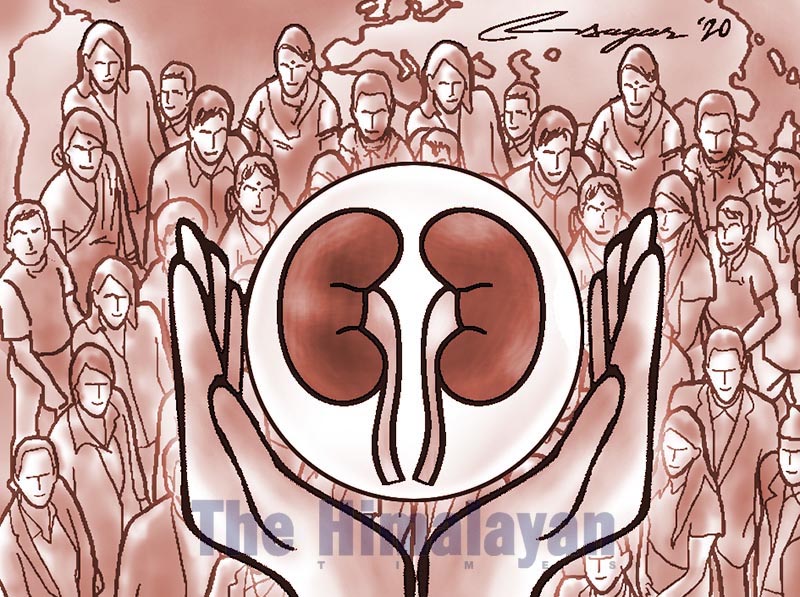Kidney ailment: Prevention is the best option
Kidney disease can be prevented, cured, and progression to end-stage kidney disease delayed with timely diagnosis and treatment. This requires making basic diagnostics and early treatment options accessible everywhere
The World Kidney Day is celebrated on the second Thursday of March every year to raise awareness and curb the incidence and impact of kidney disease worldwide. This year’s theme for the day is “Kidney Health for Everyone, Everywhere - from Prevention to Detection and Equitable Access to Care”. Specifically, the 2020 campaign draws attention towards preventive interventions to avert the onset, progression and resulting complications of kidney disease.
The burden of kidney disease is increasing at an alarming rate globally. Nevertheless, the good news is that kidney disease can be prevented, cured, and progression to end-stage kidney disease (ESRD) delayed with timely diagnosis and treatment. This calls for making basic diagnostics and early treatment options equitably accessible everywhere, for everyone. Although many countries have policies to address non-communicable diseases (NCDs), due to lack of proper management and specific strategies to increase awareness regarding kidney health, available health facilities and treatment options, and screening of kidney ailments, the status of kidney disease hasn’t shown any significant improvement.
Thus, raising awareness among the general population and policymakers regarding prevention and importance of early diagnosis and treatment is the most important aspect to halting the increasing incidences of chronic kidney diseases.
There are three levels of prevention: Primary level, which aims at preventing disease or injury before it occurs. Secondary level aims at reducing the impact of a disease that has already occurred. Tertiary level of prevention aims at shrinking the impact of an ongoing illness that has enduring effects.
Primary level of prevention mainly focusses on measures like prevention and proper management of diabetes, hypertension, improvement in the lifestyle factors like adopting a healthy diet, ceasing smoking, maintaining an ideal Body Mass Index (BMI), proper regulation of hazardous chemicals and drugs, immunisation against infectious diseases and regular follow up in case anyone is at high risk of kidney disease.
The main aim of secondary prevention is to keep hypertension and diabetes in control since these are the major modifiable risk factors for chronic kidney disease. Secondary prevention is achieved through early diagnosis, treatment, regular follow-ups, investigation, diet modifications like decreased salt and protein-rich food and more of organic food. Cardiovascular disease (CVD) is common and often fatal in people with chronic kidney disease (CKD).
The goal of tertiary prevention is to improve the quality of life by reducing disability, delaying complications, and restoring function. This is done by treating the disease to the best possible level and providing rehabilitation by coordinated use of medical, social, educational and vocational measures for training and retraining patients to the highest possible level of functional ability.
The treatment of chronic kidney disease is very expensive. Thus, it is paramount that people are well informed about the importance of kidney health and the social, psychological, financial sufferings one must go through in the event of CKD. The World Kidney Day-2020 calls on everyone to advocate concrete measures to promote and advance kidney disease prevention. They include revitalising primary health care, awareness and educational programmes, including patient empowerment and inter specialty training; incorporating CKD prevention into the national NCD programmes for comprehensive and integrated services to improve early detection and tracking of CKD at the country level; and multi sectoral collaboration - cooperation between government and the people, and incorporating health in all policy makings.
The journey of kidney transplantation in Nepal dates from 2008, when TUTH and Bir Hospital started the service in the same year. And in 2016, the promulgation of a new transplant act opened doors for organ transplantation from brain dead, or cadaveric donors. Since then, Shahid Dharmabhakta National Transplant Centre (SDNTC) has successfully conducted six brain-dead donor kidney and one brain-dead donor liver transplantation. The centre alone has carried out 693 live donor kidney transplants with 99 per cent success rate over a seven-year period. It is a matter of pleasure for Nepal to be able to carry out kidney transplantation inside the country. Just last week, our Prime Minister opted to undergo a kidney transplant in the country itself, invariably fostering people’s trust upon the quality of such service here.
Despite the achievements Nepal has made, we can’t deny that the treatment services for kidney disease are quite centralised and very expensive. The best approach is, thus, “prevention”. Some of the important modifiable measures that can help keep kidney diseases at bay are: Keep your blood sugar and blood pressure level under control; maintain an ideal weight; eat healthy and low-calorie food; exercise regularly; drink plenty of water; avoid smoking; and over the counter drugs; and get your kidneys checked through a simple blood and urine test at least once a year.
Shrestha is Executive Director and senior kidney & liver transplant surgeon at SDNTC, Bhaktapur






